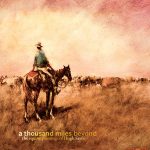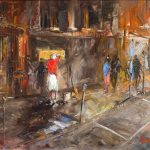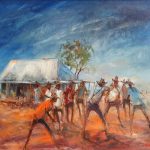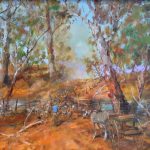Early tin Quartpot hand painted by Hugh Sawrey – SOLD
Detail photos for this Artwork
Early Quart Pot, hand painted by legendary artist Hugh Sawrey CBE (1919-1999)
Notes from Tiffany Jones Fine Art Consultant, Hugh Sawrey Specialist
It is with much pleasure that I announce the arrival of this very special item – an old tin Quart Pot, hand painted by the much loved and iconic outback artist Hugh Sawrey.
The piece emanates from a private Queensland collection and has been held in the same family since it was originally given by Hugh Sawrey in 1985 as a gift to one his great friends, as a third Birthday present for her son. Sawrey’s friend was a passionate art collector, a strong supporter of the establishment of the Stockman’s Hall of Fame at Longreach.
This quart pot’s character and patina with hand-worn imperfections, dents and small patches of wear, come about from it’s age and having been a personal item of Hugh Sawrey, which gives the piece its authenticity and unique charm.
A Quart Pot is basically a portable boiling pot, or Billy, with a companion cup, generally used for camping. The name ‘Quart” derives from the imperial measurement scale, because the pots generally held a quarter of a gallon, or about 750 ml.
When you first view this Quart Pot, it may not strike you as important, but this humble little item is a wonderful historical symbol of much of Australia’s more recent history and folklore, with its origin dating back to Victoria’s Gold Rush days and linked to the pioneers and bushmen of the outback. Quart pots were also taken overseas into battle by Australian soldiers, notably by Light Horse Regiments, and used by soldiers in Papua New Guinea. Add to this its adornment by Hugh Sawrey, and it then becomes a very special item worthy of greater appreciation.
This Quart Pot was most likely manufactured sometime between 1930 to 1950. Quart pots from this early era were made from tin plate and soldered, as it this lovely one painted by Sawrey. Tin quart pots are now a rarity because after the end of World War II, tin versions ceased to be readily made, and were superseded by stainless steel models, some of which are now made by RM Williams.
Quart pots are an essential part of any stockman’s or drover’s camping kit, taken with them on horseback while they move cattle across many kilometres on inland stock routes. From its origins as a Billy-can used on the Gold fields, the quart pot has evolved in shape and function. Their oval shape evolved away from the bulkier circular versions, so they would be easier for bushmen and stockmen to carry inside a leather pouch and when transported lain flat against the side of a horse.
Slotting into each other, when pulled apart, the larger and wide bottom end of the quart pot is the Billy, or boiling pot, which is placed over a campfire to heat food or boil water for tea. The warmed brew or food is then poured into the upper lid which is used as a drinking cup or bowl. Compact folding handles at the sides and on the top allow the pot to be pushed into a fire, and also held conveniently like a cup or kettle.
Australian billy-cans date back to Victoria’s early gold-mining days, when fresh food was hard to procure and difficult to transport to the diggings.
Large supplies of preserved provisions were imported to deal with the problem, including tinned meats, stews and soups, some of which came from France with the brand name “Bouilli” (translating to mean boiled meat). Bouilli, or bully beef, was popular with the miners, but they had difficulty pronouncing “Bouilli”, so reverted to “Billy”.
Being a handy size, the tins were re-used as makeshift kettles to boil water, and so the legend of the “billy-can” began and before long they were manufactured and appeared on the market as the billy-can, pint-pot and quart-pot, with neatly made lids and wire handles.
Billies have now become part of our folklore with poems, songs and bush competitions devoted to this humble but practical item that brought comfort to miners, and to stockmen and drovers making camp and taking “smoko” breaks as they traversed the stock routes on long hard rides.
The average bushman considers billy tea the drink of drinks, and there is an art in preparing good billy tea. A Billy is at its best when it becomes stained and blackened with use. A blackened tin quart pot is valued highly because the tea brewed in a weathered pot produces a superior and richer flavour; and, the older the pot, the quicker it boils. Billy-boiling contests were once popular in the Australian bush and experts were known to keep billies of tissue-paper thinness, that could boil in two minutes.
Dropping a stone into another man’s billy is an old camp-fire joke. A “doped” billy takes much longer to boil, much to the exasperation of whoever is the brunt of the prank.
Coincidentally, in Hugh Sawrey’s own self portrait oil painting that he donated to the Stockman’s Hall of Fame, he appears holding a quart pot, an essential part of his kit during the many years he worked as a stockman and drover on stations in the Northern Territory and Queensland.
Sawrey also created a painting (The Old Greenhide Quartpot Pouch – A Vision Splendid) that depicted very simply his quart pot encased in a his handmade greenhide leather pouch and inscribed with the names of the stations he worked on. This pouch and quartpot hung on a nail in his Studio. Sawrey attributed it as being the item that first inspired him to set about the process of founding a Stockman’s Hall of Fame in Australia.
Who would have thought that the humble little quart pot could mean so much!























































































